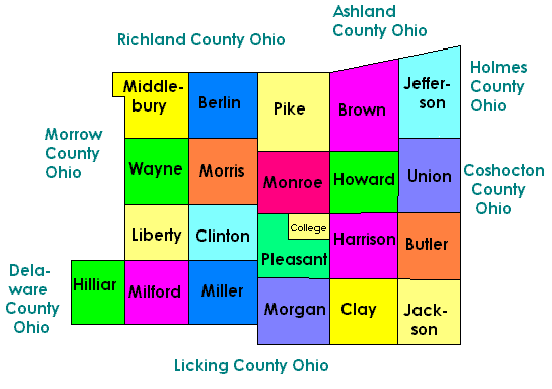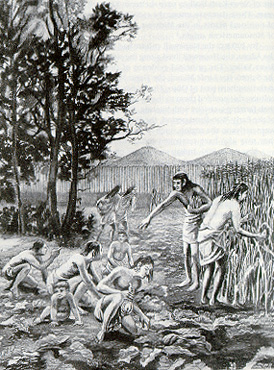
Map of Knox County and its twenty-two townships
Knox County Demographics and History
| Knox County is located in central Ohio. Twenty-two townships make up the county, which has a population of about 45,000. The county seat of Knox County is Mount Vernon, with a population of about 15,000. |
Map of Knox County and its twenty-two townships |
An ancient race of people called the "Mound Builders" lived in the area that is now Knox County. There
is a good deal of speculation in the county histories about the origin of these people; popular consensus traces
them back to Asia. The Mounds that they are believed to have left behind indicate that these people had a fairly
advanced culture. Prior to the arrival of European settlers, Native Americans of Knox County used stone hatchets,
pointed sticks, and bone shovels and hoes.
 |
Before the Fort McIntosh treaty of 1785 was reestablished in 1795, Knox County was occupied almost entirely by Native Americans. The indigenous peoples who inhabited the area were the Delawares, although the lack of clear-cut boundaries would have allowed other Native American groups to settle in the area as well. The treaty of 1785 assigned the Native American tribes to the westward portion of Ohio, forcing them from their previous homeland. The area was steadily settled by pioneers, mostly from Pennsylvania beginning in the early 19th century. According to county histories (Hill et. al) Native Americans had a good deal of communication with the settlers although the relationship was not harmonious. Various treaties were used to displace the Native Americans, although some resided in the area until the war of 1812. Mount Vernon was laid out and named in 1805. On January 30th, 1808 Knox County was created and Mount Vernon was named the County seat. The County was named for General Henry Knox, a distinguished officer in the revolutionary army. |
Around 1790, the first pioneers of Knox County settled the land along a winding river which the Indians called Owl Creek. They cleared away heavy timber, erected log houses, and plowed a few acres to plant grains and corn. Some early settlers, drawn by new economic opportunities further west, sold their cleared plots to newcomers, who added fencing and expanded the fields to create established farmsteads. Not all pioneers were farmers, however. Carpenters, masons, plasterers, and blacksmiths were common professions among the pioneers.
The majority of the early settlers of Knox County were of European descent, such as English, Irish, German and Scotch-Irish. Between 1810 and 1840, the population expanded greatly as settlers, primarily from Pennsylvania, moved into the area. By 1840 the population had peaked, yet even though the population did not fluctuate much after 1840, there continued to be movement of people within Knox County, as many people moved into villages. For instance Mount Vernon's population grew from 4,876 in 1870 to 12,185 in 1950.
Population of Knox County
| 1800: none | 1900: 27,768 |
| 1810: 2,149 | 1930: 29,338 |
| 1840: 29,579 | 1960: 38,808 |
| 1870: 28,333 | 1990: 47,473 |
Between 1815 and 1830, the county primarily consisted of Protestant churches, including the Evangelical, Baptist, Episcopal, and Methodist Church. Also noted was a small community of Quakers among the early settlers as well. The Amish arrived later in Knox County, in the mid-20th century, but has grown considerably since this time. Amish families moved from other places in Ohio, Indiana and Pennsylvania to Knox County because it had not been urbanized and land was cheap. A population of members of the Church of Latter Day Saints County was not noted in Knox until the mid-20th century. There was a small Jewish population, primarily near Mount Vernon, which was acknowledged when they established a small synagogue in 1867. Most Jewish residents came from other places in America, rather than from abroad. However, Knox County did receive some immigrants from Germany during World War II.
By 1850 there were 28,872 people living in Knox County. At the time, immigrants made up only four percent of the population, and were settled primarily in the Southeast section of the county. The Western European nationalities represented included Canadians, English, French, Germans, Irish, Scottish, Swiss, and Welsh. The Irish were early arrivals to the county and were concentrated around Mount Vernon and Danville. The influx of the Irish was slow in the first three decades of the County, but began to grow more quickly as railroad and canal construction, as well as a growth in manufacturing, lured them to the area. Knox County also was home to a sizeable Belgian community, which developed around the glass factories which moved into the area in the early 1900s.
There has never been an African American residential area in Knox County. African Americans have never comprised a large part of the population of Knox County, but they have resided in Knox County as long as European Americans. As of 1850, there were only 62 African Americans who exclusively resided in the central part of the county. In 1970, African Americans still made up less than one-percent of the population. Many of the early African Americans in the County came from Virginia, and some were brought by anti-slavery Quakers.
The history of Knox County reveals its diversity. Although many populations were small, there were people of different races, ethnicities, and religions living in Knox County throughout its history.
| Back to Home |